Off-grid living can be an incredibly rewarding experience, but it also has a lot of extra responsibilities. To live self-sufficiently, you need to equip yourself with the best septic system for your needs, and this guide will help you make the right choice.
Different Septic System Types
There are many types of septic systems available, from basic bucket systems to advanced aerobic treatment units. The most common type of all is the traditional gravity system, which works by allowing gravity to move effluent from the house to a septic tank and a leach field. This type of system is normally best for small households with low water usage and an appropriate soil type for drainage and absorption.
For off-grid living, a dry or composting toilet system may be the best choice. These systems use no water and allow for the decomposition of solids to take place above-ground. Since off grid homes rarely use more than one to two gallons of water a day from household usage, these systems are ideal because they don’t need a larger septic tank or leach field. However, it is essential that the organic materials from the toilet are removed and replaced periodically.
Size Matters: Choosing the Right Septic Tank Capacity
When selecting a septic system, one of the most important considerations is finding the right tank size for your home. The size of the tank depends on the number of bedrooms in your home and the average daily water usage. A larger family that uses more water will require a much larger tank than a smaller one. It’s important to select a tank that can adequately hold all the household wastewater in order to provide optimal performance and longevity.
Typically, a two to three-bedroom home will need between 1,000-gallon and 1,500-gallon capacity. However, if the household uses a large amount of water on a daily basis, such as doing multiple loads of laundry or taking frequent long hot showers, then the tank capacity may need to be increased by five hundred gallons or more. Additionally, septic tanks come in two varieties. Concrete septic tanks are better for off grid living because they have great insulation from changing temperatures and can last for many years without an issue. Plastic septic tanks are less expensive but should not be used for off grid living because drastic temperature changes can cause them to crack and become damaged over time.
Exploring Alternative Septic Systems
Alternative septic systems such as aerobic treatment units (ATUs) or rainwater harvesting systems are ideal for off-grid living. These innovative septic tanks use less energy and provide better overall water quality than traditional systems. Rainwater harvesting systems capture and store runoff water to irrigate gardens, clean driveways, and even flush toilets! Aerobic treatment units provide improved water quality over typical septic tanks by breaking down organic contamination with bacteria, air and oxygen. These alternative solutions combine reuse of wastewater with sustainability, making them a great choice for off-grid living.
Of course, choosing the right system for your off-grid living setup will depend on many factors. Careful consideration should be given to soil type, number of residents in the home and usage patterns. These are all important considerations when deciding which septic system is best for your situation. Research online or talk to a local professional who specializes in alternative septic systems to determine the best option for you. With the right system in place, you can enjoy an environmentally friendly lifestyle while protecting your family’s health.
Sealing the Tank: Know Your Soil Type and Climate
One of the most productive ways to ensure that your septic tank functions the way it should is by proper sealing. Before you invest money in a system, you need to know your soil type and climate to make sure it can protect against water loss and/or additional contamination. Concrete or plastic based tanks offer varying levels of infiltration resistance and require different lengths of time for installation.
Choosing the right septic tank will also depend on your location and type of home you’re living in. Plastic tanks are designed primarily for domestic or commercial purposes, while concrete tanks are best suited for areas where ground temperatures drop below freezing. Additionally, soil permeability plays a major role in your decision-making process as well. Sandy soil, for example tends to absorb moisture quickly while clay soils take longer to absorb water. Furthermore, if your area is prone to flooding select a sealed septic tank that won’t be affected by water damage due to rising water levels.
Pros & Cons of All Types of Off-Grid Septic Systems
Depending on where you live, what size storage tank and associated waste pipes you need, and your budget, there are several types of septic systems. Generally, the pros and cons of each system include installation time and cost as well as its durable design. For example, concrete tanks require long-term use in low infiltration soils that are difficult to dig but may require additional certifications for approval. Whereas plastic tanks offer fast installation times with fewer regulations or restrictions. Ultimately, you should do your research to find the best system for your off grid living lifestyle.

